Research on Damage Evolution Mechanism of Layered Rock Mass under Blasting Load
Abstract
:1. Introduction
2. Damage Evolution of the Intact Rock
2.1. Numerical Model
2.2. Constitutive Model
2.3. Initiation Method
2.4. Numerical Result
2.4.1. Bottom Detonation
2.4.2. Midpoint Detonation
2.4.3. Top Detonation
3. Damage Evolution Process of Layered Rock Masses
3.1. Numerical Model
3.2. Numerical Result
3.2.1. Top Detonation
3.2.2. Midpoint Detonation
3.2.3. Bottom Detonation
4. Result and Discussion
4.1. The Effect of Location of Initiation Points
4.2. The Effect of Joint Distribution
5. Conclusions
- (1)
- The nature of the effect of the initiation point location on the rock-fragmentation efficiency is that the initiation methods influence the stress concentration and high-energy distribution of rock mass under blasting. The superposition among the stress waves in the blasthole has a certain impact on the damage range of the rock mass.
- (2)
- Top detonation shows the most serious damage to rock mass at the blasthole bottom, the damaging effect to the rock mass in the middle of the blasthole is poor using the middle initiation method, and the initiation in the bottom has a good effect on the fragmentation to rock mass.
- (3)
- Due to the existence of joints, rock damage under blasting load shows a non-symmetrical distribution. A series of complex transmission and reflection processes occur when the stress wave propagates to the upstream surface of the multiple-layered joints, which intensifies the rock damage on the upstream surface. Furthermore, the damage to rock mass on the downstream surfaces of multiple layered joints is obviously weakened. The joints have a certain shielding effect on the blasting stress wave propagation for the rock on the back side of the joints.
Author Contributions
Funding
Data Availability Statement
Conflicts of Interest
References
- Mosinets, V.N.; Gorbacheva, N.P. A seismological method of determining the parameters of the zones of deformation of rock by blasting. Sov. Min. 1972, 8, 640–647. [Google Scholar] [CrossRef]
- Kutter, H.K.; Fairhurst, C. On the fracture process in blasting. Int. J. Rock Mech. Min. Sci. 1971, 8, 181–202. [Google Scholar] [CrossRef]
- Brinkmann, J.R. An experimental study of the effects of shock and gas penetration in blasting. In Proceedings of the 3rd International Symposium on Rock Fragmentation by Blasting, Brisbane, Australia, 26–31 August 1990. [Google Scholar]
- Daehnke, A.; Rossmanith, H.P.; Napier, J.A.L. Gas pressurisation of blast-induced conical cracks. Int. J. Rock Mech. Min. Sci. 1997, 34, 263.e1–263.e17. [Google Scholar] [CrossRef]
- Cho, S.H.; Kaneko, K. Influence of the applied pressure waveform on the dynamic fracture processes in rock. Int. J. Rock Mech. Min. Sci. 2004, 41, 771–784. [Google Scholar] [CrossRef]
- Zhu, Z.M.; Xie, H.P.; Mohanty, B. Numerical investigation of blasting-induced damage in cylindrical rocks. Int. J. Rock Mech. Min. Sci. 2008, 45, 111–121. [Google Scholar] [CrossRef]
- Yang, R.S.; Wang, Y.B.; Xue, H.J.; Wang, M.Y. Dynamic behavior analysis of perforated crack propagation in two-hole blasting. Procedia Earth Planet. Sci. 2012, 5, 254–261. [Google Scholar]
- Yang, R.S.; Ding, C.X.; Yang, L.Y.; Lei, Z.; Zhang, Z.; Wang, Y. Visualizing the blast-induced stress wave and blasting gas action effects using digital image correlation. Int. J. Rock Mech. Min. Sci. 2018, 112, 47–54. [Google Scholar] [CrossRef]
- Xie, L.X.; Lu, W.B.; Zhang, Q.B.; Jiang, Q.H.; Chen, M.; Zhao, J. Analysis of damage mechanisms and optimization of cut blasting design under high in-situ stresses. Tunn. Undergr. Space Technol. 2017, 66, 19–33. [Google Scholar] [CrossRef]
- Mahdi, S.F.; Cagri, G.; Zhou, M.L.; Kordestani, H.; Muho, E.V. Estimation of Damage Induced by Single-Hole Rock Blasting: A Review on Analytical, Numerical, and Experimental Solutions. Energies 2020, 14, 29. [Google Scholar] [CrossRef]
- Qiu, P.; Yue, Z.W.; Yang, R.S.; Ju, Y. Modified mixed-mode caustics interpretation to study a running crack subjected to obliquely incident blast stress waves. Int. J. Impact Eng. 2021, 150, 103821. [Google Scholar] [CrossRef]
- Li, X.D.; Liu, K.W.; Sha, Y.Y.; Yang, J.; Ma, S.; Hong, Z. Investigation on radial fracturing around blasthole under combined static stress and blasting. Theor. Appl. Fract. Mech. 2023, 127, 104038. [Google Scholar] [CrossRef]
- Li, N.; Zhang, P.; Duan, Q.W.; Swoboda, G. Dynamic damage model of the rock mass medium with microjoints. Int. J. Damage Mech. 2003, 12, 163–173. [Google Scholar]
- Lin, Q.B.; Cao, P.; Meng, J.J. Strength and failure characteristics of jointed rock mass with double circular holes under uniaxial compression: Insights from discrete element method modelling. Theor. Appl. Fract. Mech. 2020, 109, 102692. [Google Scholar] [CrossRef]
- Huang, J.; Chen, S.H.; Liu, M.L.; Li, K.P. Physical model test and numerical simulation study of cumulative damage to deep tunnel surrounding rock under cyclic blasting load. Int. J. Damage Mech. 2023, 32, 161–184. [Google Scholar] [CrossRef]
- Rossmanith, H.P. Fracture and damage of concrete and rock. In Proceedings of the Second International Conference on Fracture and Damage of Concrete and Rock, Vienna, Austria, 9–13 November 1992. [Google Scholar]
- Wu, L.; Chen, J.P. Study on Smooth-Blasting Results in Jointed and Fractured Rock. J. China Univ. Geosci. 2001, 12, 145–149. [Google Scholar]
- Li, H.B.; Xia, X.; Li, J.C.; Jian, Z.; Bo, L.; Yaqun, L. Rock damage control in bedrock blasting excavation for a nuclear power plant. Int. J. Rock Mech. Min. Sci. 2011, 48, 210–218. [Google Scholar]
- Li, J.C.; Li, H.B.; Zhao, J. An improved equivalent viscoelastic medium method for wave propagation across layered rock masses. Int. J. Rock Mech. Min. Sci. 2015, 73, 62–69. [Google Scholar] [CrossRef]
- Fan, L.F.; Wang, L.J.; Wu, Z.J. An investigation of propagation direction induced difference of transmission coefficient in complex rock mass. Int. J. Rock Mech. Min. Sci. 2020, 135, 104504. [Google Scholar] [CrossRef]
- Guo, X.; Ding, C.X.; Wei, P.J.; Yang, R.S. Theoretical analysis of the interaction between blasting stress wave and linear interface crack under high in-situ stress in deep rock mass. Int. J. Rock Mech. Min. Sci. 2024, 176, 105723. [Google Scholar] [CrossRef]
- Chen, X.; Li, J.C.; Cai, M.F.; Zou, Y.; Zhao, J. Experimental study on wave propagation across a rock joint with rough surface. Rock Mech. Rock Eng. 2015, 48, 2225–2234. [Google Scholar] [CrossRef]
- Zou, Y.; Li, J.C.; Zhao, J. A novel experimental method to investigate the seismic response of rock joints under obliquely incident wave. Rock Mech. Rock Eng. 2019, 52, 3459–3466. [Google Scholar] [CrossRef]
- Liu, Y.; Lu, C.P.; Liu, B.; Zhang, H.; Wang, H.Y. Experimental and field investigations on seismic response of joints and beddings in rocks. Ultrasonics 2019, 97, 46–56. [Google Scholar] [CrossRef]
- Xia, Y.J.; Zhang, C.Q.; Zhou, H.; Chen, J.; Gao, Y.; Liu, N.; Chen, P. Structural characteristics of columnar jointed basalt in drainage tunnel of Baihetan hydropower station and its influence on the behavior of P-wave anisotropy. Eng. Geol. 2020, 264, 105304. [Google Scholar] [CrossRef]
- Han, Z.Y.; Li, D.Y.; Zhou, T.; Zhu, Q.; Ranjith, P.G. Experimental study of stress wave propagation and energy characteristics across rock specimens containing cemented mortar joint with various thicknesses. Int. J. Rock Mech. Min. Sci. 2020, 131, 104352. [Google Scholar] [CrossRef]
- Li, Y.S.; Zhu, J.B.; Han, D.Y.; Zhao, R.; Ma, Y.; Zhou, T. Experimental study of the dynamic responses of surrounding jointed rock masses and adjacent underground openings and induced ground vibrations subjected to underground explosion. Tunn. Undergr. Space Technol. 2023, 135, 105060. [Google Scholar] [CrossRef]
- Zhang, Y.T.; Yang, R.S.; Chen, C.; Li, C.; Luo, H. Analysis of the blasting effect of strip cartridge position on jointed rock mass. Mech. Adv. Mater. Struct. 2023, 30, 1249–1259. [Google Scholar] [CrossRef]
- Wang, Q.R.; Song, E.X.; Xu, P.; He, Y.; Shi, X.; Xie, H. Dynamic Performance and Stress Wave Propagation Characteristics of Parallel Jointed Rock Mass Using the SHPB Technique. KSCE J. Civ. Eng. 2023, 27, 2275–2286. [Google Scholar] [CrossRef]
- Lu, H.; Pan, Y.; He, K.; Wang, F.; Gao, L.; Pu, S.; Li, E. Dynamic Mechanical Properties and Damage Evolution Characteristics of Beishan Deep Granite under Medium and High Strain Rates. Materials 2023, 16, 5235. [Google Scholar] [CrossRef]
- Li, Z.; Hu, Y.; Wang, G.Z.; Zhou, M.; Hu, W.; Zhang, X.; Gao, W. Study on cyclic blasting failure characteristics and cumulative damage evolution law of tunnel rock mass under initial in-situ stress. Eng. Fail. Anal. 2023, 150, 107310. [Google Scholar] [CrossRef]
- Li, X.F.; Zhang, Q.B.; Li, H.B.; Zhao, j. Grain-Based Discrete Element Method (GB-DEM) Modelling of Multi-scale Fracturing in Rocks Under Dynamic Loading. Rock Mech. Rock Eng. 2018, 52, 3785–3817. [Google Scholar] [CrossRef]
- Lak, M.; Marji, M.F.; Bafghi, A.Y.; Abdollahipour, A. Analytical and numerical modeling of rock blasting operations using a two-dimensional elasto-dynamic Green’s function. Int. J. Rock Mech. Min. Sci. 2019, 114, 208–217. [Google Scholar] [CrossRef]
- Luo, Y.; Wang, G.; Li, X.P.; Liu, T.; Mandal, A.K.; Xu, M.; Xu, K. Analysis of energy dissipation and crack evolution law of sandstone under impact load. Int. J. Rock Mech. Min. Sci. 2020, 132, 104359. [Google Scholar] [CrossRef]
- Dong, Q.; Li, X.P.; Jia, Y.S.; Sun, J.S. A Numerical Simulation of Blasting Stress Wave Propagation in a Jointed Rock Mass under Initial Stresses. Appl. Sci. 2021, 11, 7873. [Google Scholar] [CrossRef]
- Hu, H.N.; Yang, L.Y.; Feng, C.; Zhu, X.; Zhou, J.; Liu, X. Development of BB model and investigation of P-wave propagation across jointed rock masses using CDEM. Comput. Geotech. 2024, 165, 105910. [Google Scholar] [CrossRef]
- Banadaki, D.M.M. Stress-Wave Induced Fracture in Rock due to Explosive Action. Ph.D. Thesis, University of Toronto, Toronto, ON, Canada, 2010. [Google Scholar]
- Gao, Q.D.; Lu, W.B.; Yan, P.; Hu, H.; Yang, Z.; Chen, M. Effect of initiation location on distribution and utilization of explosion energy during rock blasting. Bull. Eng. Geol. Environ. 2019, 78, 3433–3447. [Google Scholar] [CrossRef]
- Ding, C.X.; Yang, R.S.; Feng, C. Stress wave superposition effect and crack initiation mechanism between two adjacent bore-holes. Int. J. Rock Mech. Min. Sci. 2021, 138, 104622. [Google Scholar] [CrossRef]
- Fan, Y.; Niu, H.C.; Yang, G.D.; Gao, Q.; Wu, J.; Tian, B. Near-field vibration induced by single-hole blasting under different initiation modes. Eu-Ropean J. Environ. Civ. Eng. 2024, 28, 753–778. [Google Scholar] [CrossRef]
- Leng, Z.D.; Sun, J.S.; Lu, W.B.; Xie, X.; Jia, Y.; Zhou, G.; Chen, M. Mechanism of the in-hole detonation wave interactions in dual initiation with electronic detonators in bench blasting operation. Comput. Geotech. 2021, 129, 103873. [Google Scholar] [CrossRef]
- Ylitalo, R.M.; Zhang, Z.X.; Bergstro, P. Effect of detonator position on rock fragmentation: Full-scale field tests at Kevitsa open pit mine. Int. J. Rock Mech. Min. Sci. 2021, 147, 104918. [Google Scholar] [CrossRef]
- Li, D.Y.; Han, Z.Y.; Zhu, Q.Q.; Zhang, Y.; Ranjith, P.G. Stress wave propagation and dynamic behavior of red sandstone with single bonded planar joint at various angles. Int. J. Rock Mech. Min. Sci. 2019, 117, 162–170. [Google Scholar] [CrossRef]
- Ma, K.; Peng, Y.L.; Liao, Z.Y.; Wang, Z.R. Dynamic responses and failure characteristics of the tunnel caused by rockburst: An entire process modelling from incubation to occurrence phases. Comput. Geotech. 2024, 171, 106340. [Google Scholar] [CrossRef]

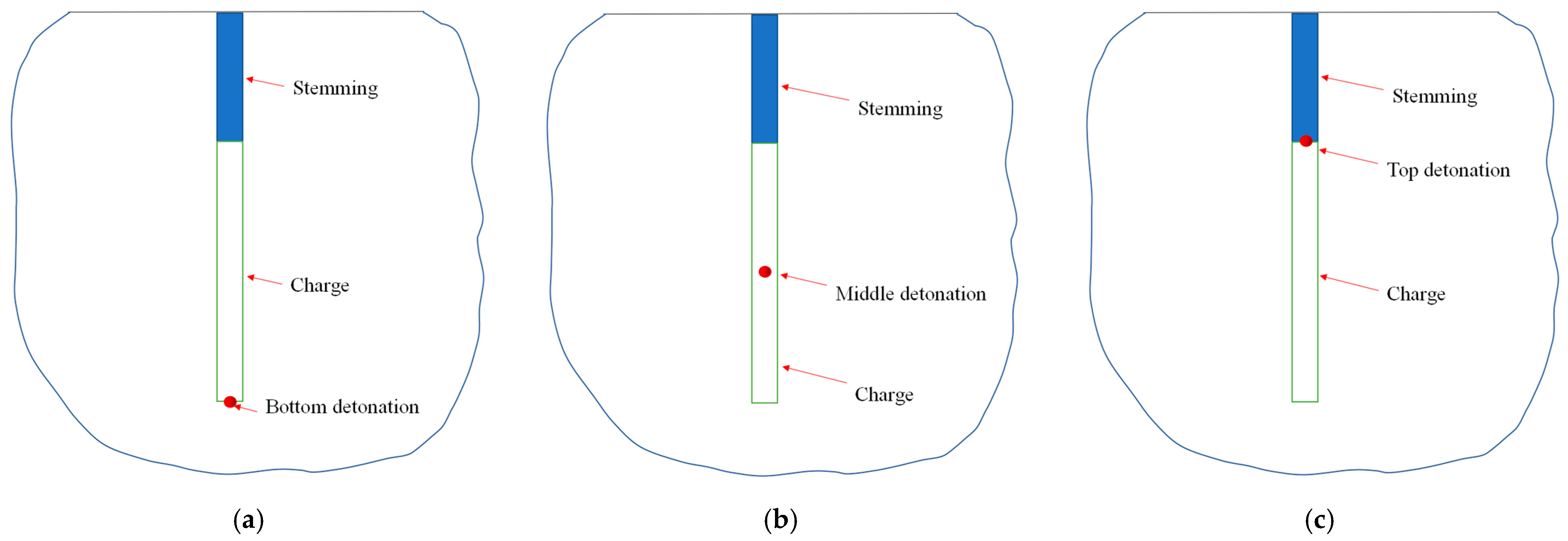


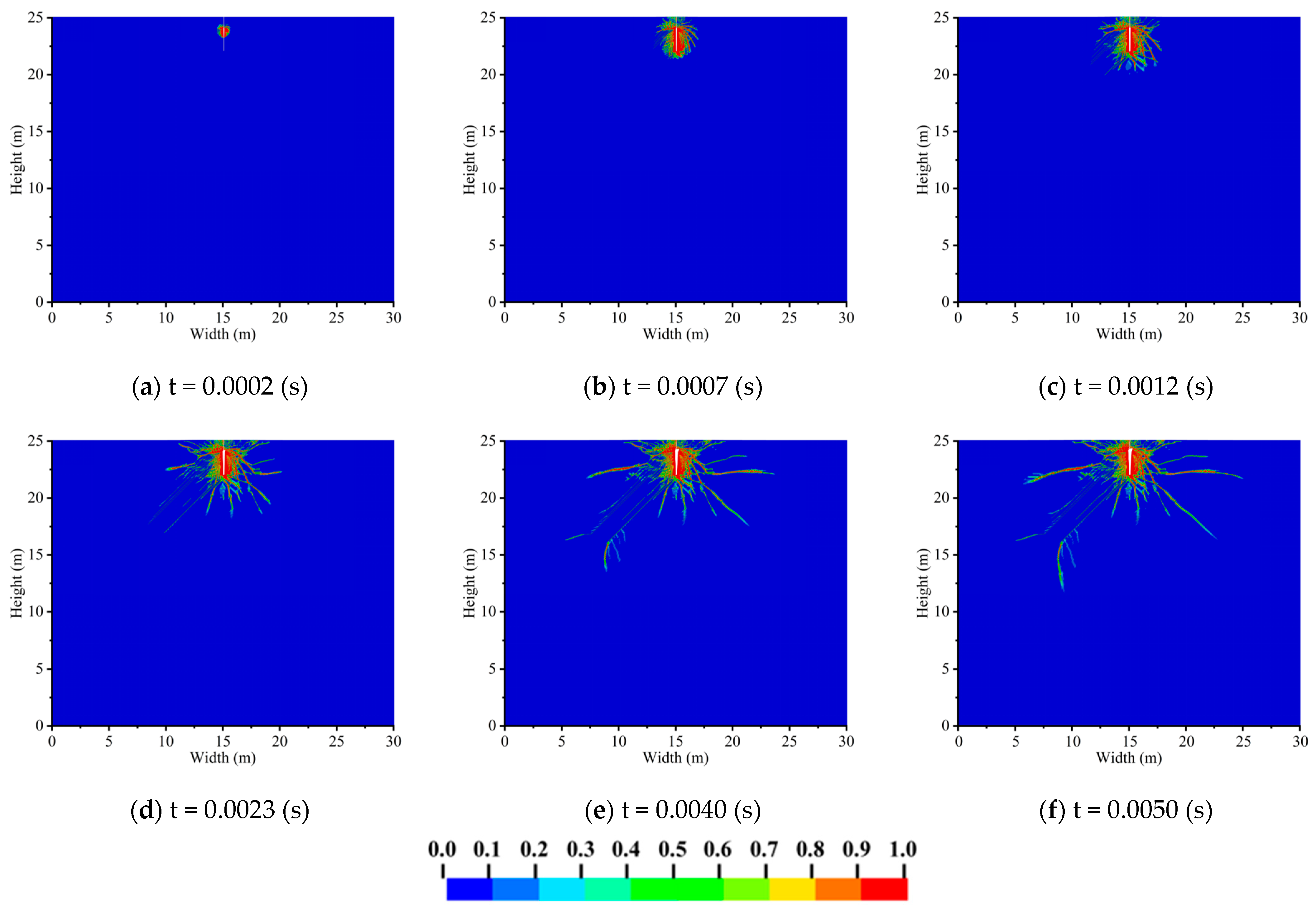
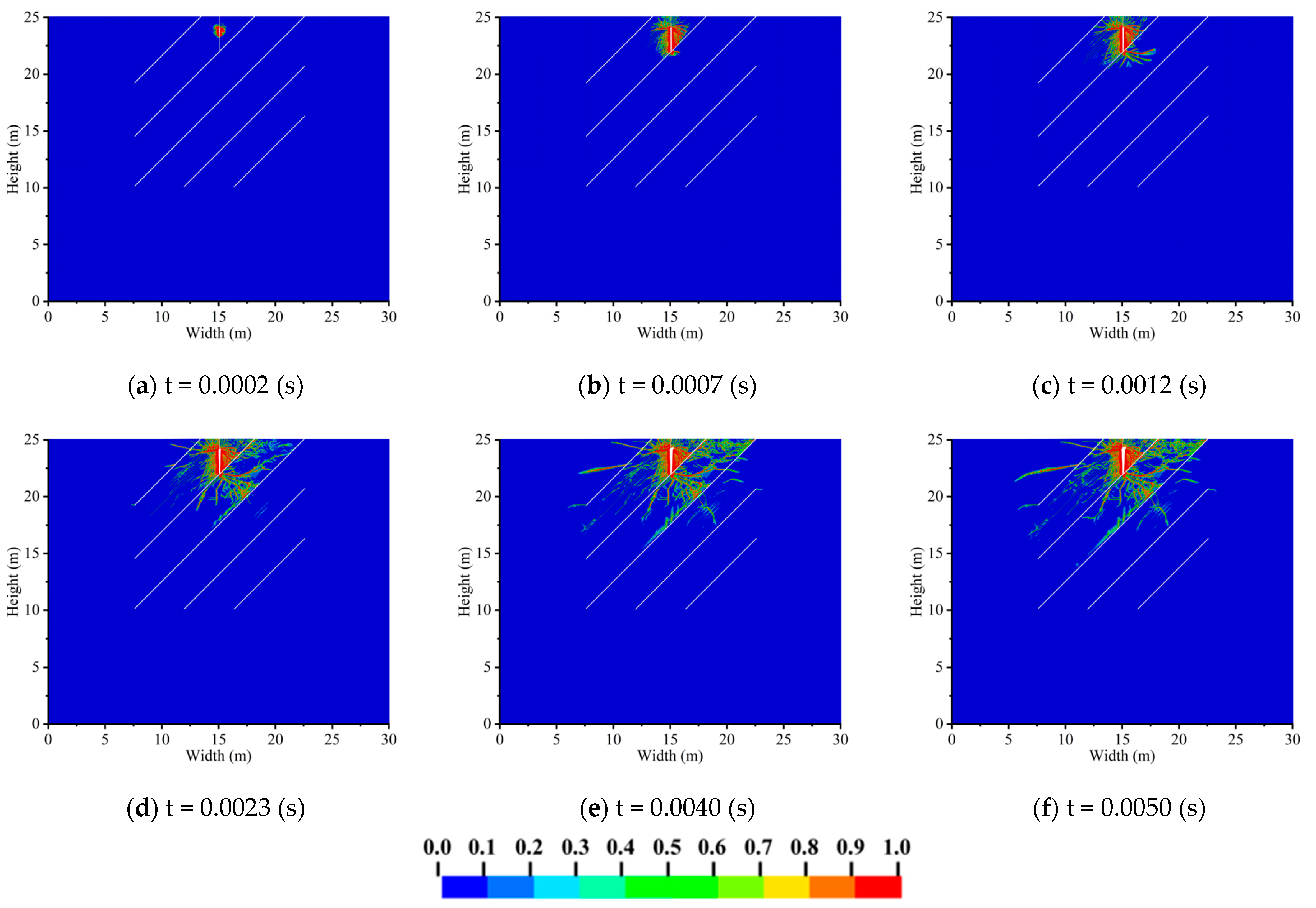
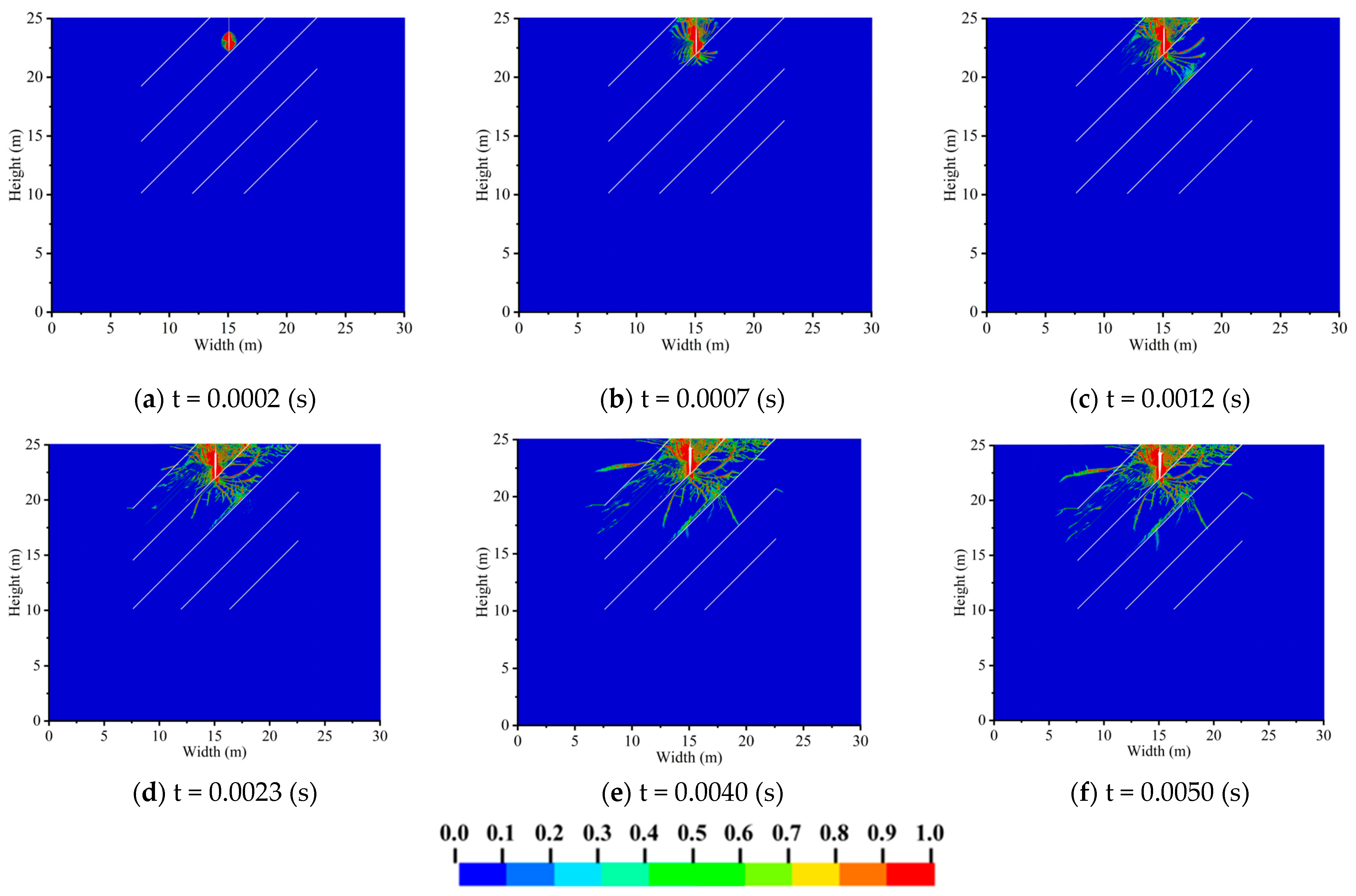




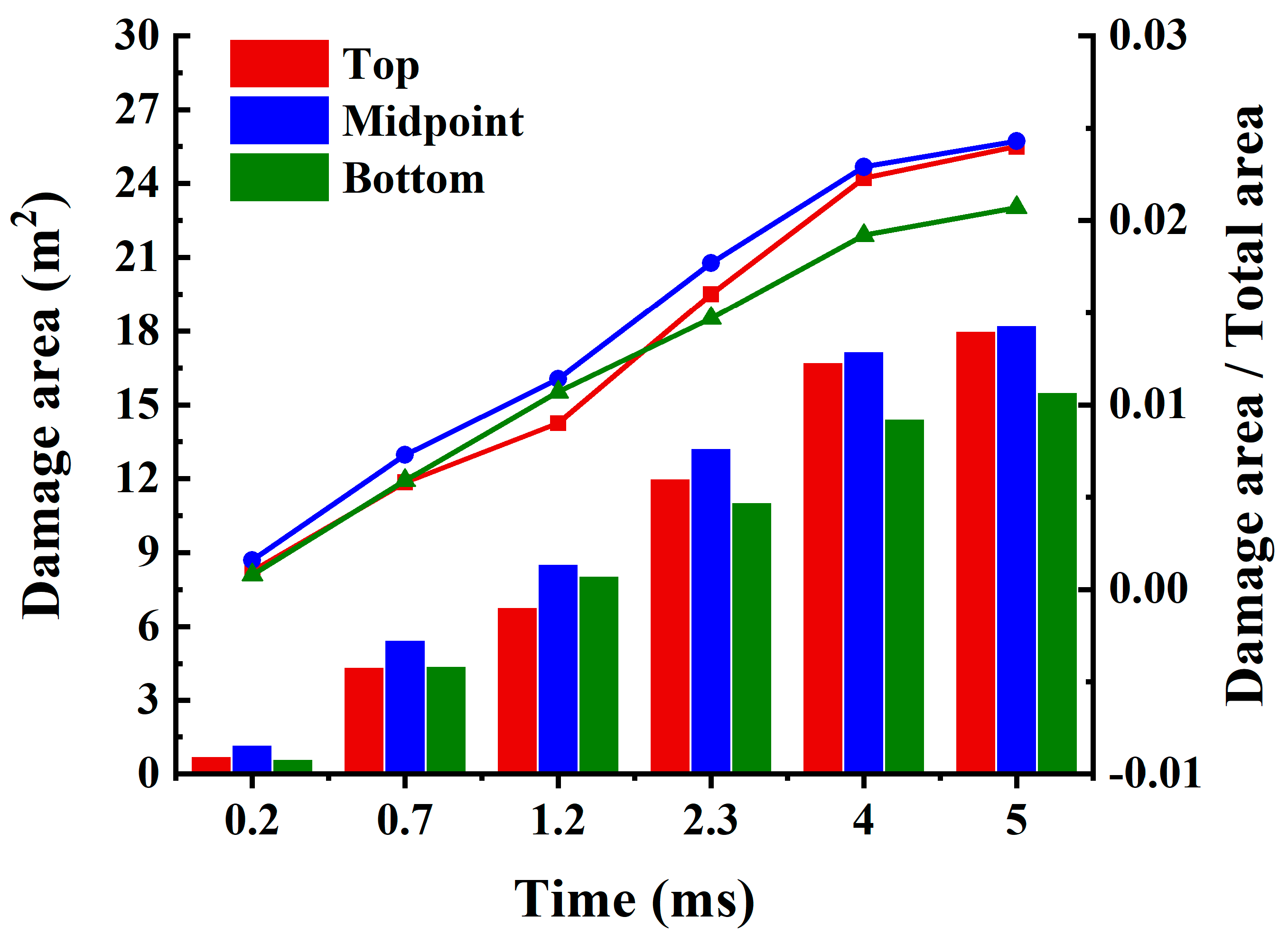
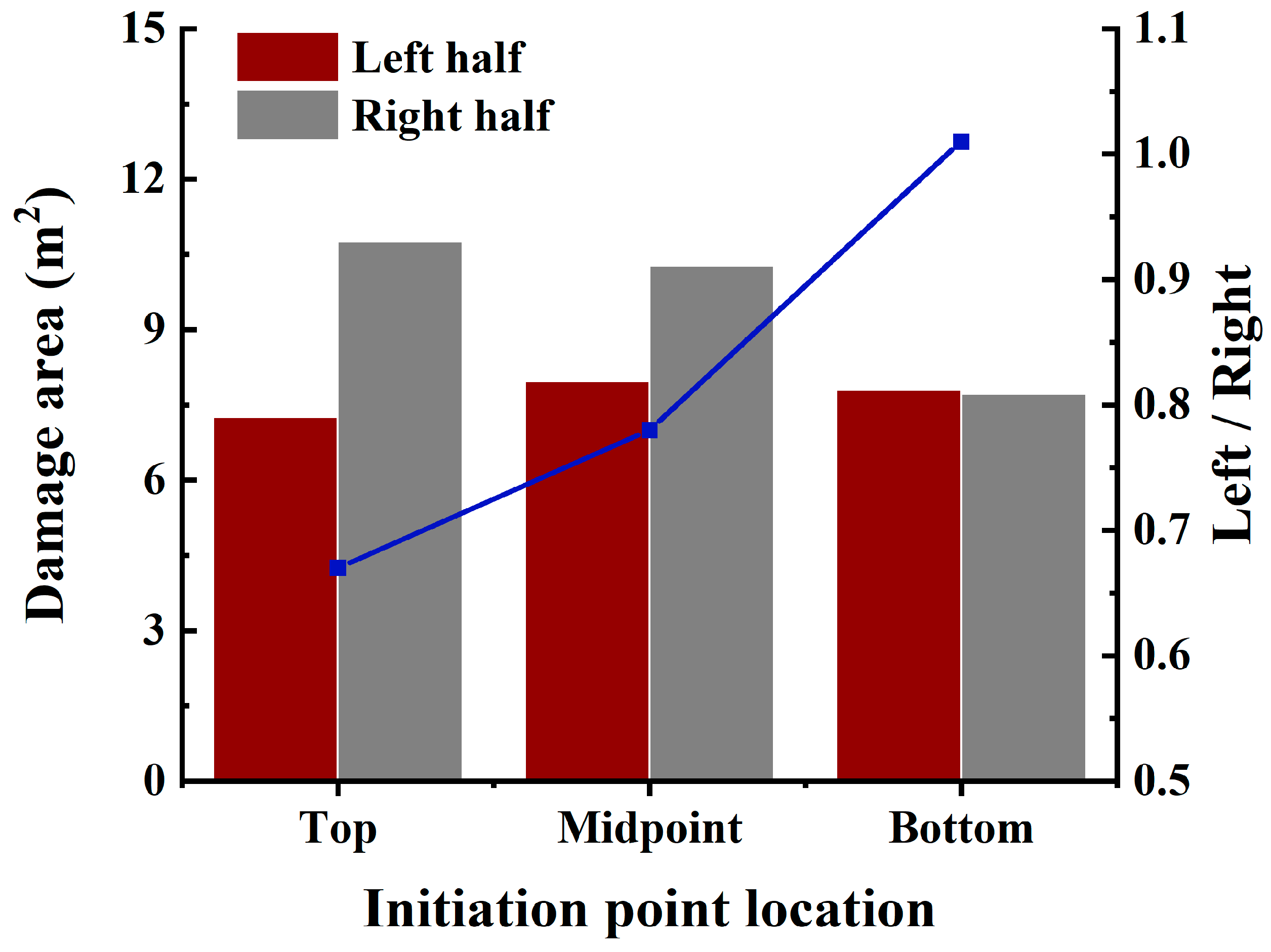
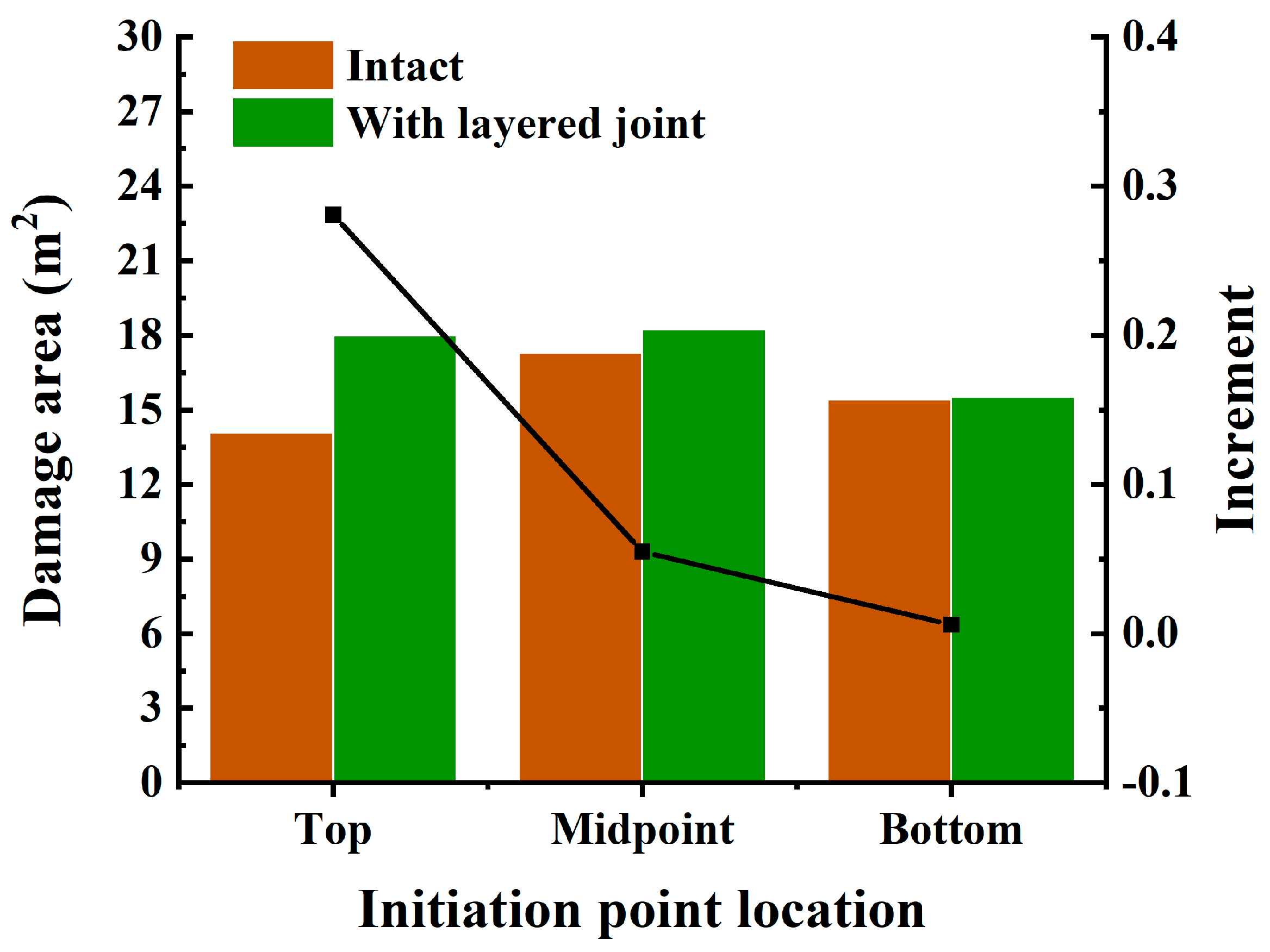
| Parameter | Value | Parameter | Value |
|---|---|---|---|
| Mass density (kg/m3) | 2660 | Poisson’s ratio | 0.19 |
| Elastic shear modulus (GPa) | 21.9 | Relative tensile strength | 0.04 |
| Compressive strength (MPa) | 167.8 | Relative shear strength | 0.21 |
| R1 | R2 | |||||||
|---|---|---|---|---|---|---|---|---|
| 1300 | 4000 | 5.2 | 214.4 | 0.182 | 4.2 | 0.9 | 0.15 | 4.192 |
| Location | Top | Midpoint | Bottom | ||||
|---|---|---|---|---|---|---|---|
| Time (ms) | Damage Area (m2) | Proportion (%) | Damage Area (m2) | Proportion (%) | Damage Area (m2) | Proportion (%) | |
| 0.2 | 0.72 | 0.10 | 1.17 | 0.16 | 0.76 | 0.10 | |
| 0.7 | 5.09 | 0.68 | 6.05 | 0.81 | 4.90 | 0.65 | |
| 1.2 | 7.59 | 1.01 | 8.75 | 1.17 | 8.58 | 1.14 | |
| 2.3 | 10.59 | 1.41 | 12.08 | 1.61 | 11.75 | 1.57 | |
| 4.0 | 13.11 | 1.75 | 15.95 | 2.13 | 14.39 | 1.92 | |
| 5.0 | 14.06 | 1.87 | 17.28 | 2.30 | 15.42 | 2.06 | |
| Location | Top | Midpoint | Bottom | ||||
|---|---|---|---|---|---|---|---|
| Time (ms) | Damage Area (m2) | Proportion (%) | Damage Area (m2) | Proportion (%) | Damage Area (m2) | Proportion (%) | |
| 0.2 | 0.72 | 0.10 | 1.17 | 0.16 | 0.59 | 0.08 | |
| 0.7 | 4.36 | 0.58 | 5.44 | 0.73 | 4.40 | 0.59 | |
| 1.2 | 6.78 | 0.90 | 8.53 | 1.14 | 8.06 | 1.07 | |
| 2.3 | 12.00 | 1.60 | 13.25 | 1.77 | 11.05 | 1.47 | |
| 4.0 | 16.73 | 2.23 | 17.17 | 2.29 | 14.43 | 1.92 | |
| 5.0 | 18.01 | 2.40 | 18.23 | 2.43 | 15.51 | 2.07 | |
Disclaimer/Publisher’s Note: The statements, opinions and data contained in all publications are solely those of the individual author(s) and contributor(s) and not of MDPI and/or the editor(s). MDPI and/or the editor(s) disclaim responsibility for any injury to people or property resulting from any ideas, methods, instructions or products referred to in the content. |
© 2024 by the authors. Licensee MDPI, Basel, Switzerland. This article is an open access article distributed under the terms and conditions of the Creative Commons Attribution (CC BY) license (https://creativecommons.org/licenses/by/4.0/).
Share and Cite
Xie, L.; Zhang, J.; Yang, D.; Qi, Y.; Wu, L.; Chen, H. Research on Damage Evolution Mechanism of Layered Rock Mass under Blasting Load. Buildings 2024, 14, 3227. https://doi.org/10.3390/buildings14103227
Xie L, Zhang J, Yang D, Qi Y, Wu L, Chen H. Research on Damage Evolution Mechanism of Layered Rock Mass under Blasting Load. Buildings. 2024; 14(10):3227. https://doi.org/10.3390/buildings14103227
Chicago/Turabian StyleXie, Lixiang, Jiahao Zhang, Dongyu Yang, Yanjun Qi, Linjun Wu, and Hongyun Chen. 2024. "Research on Damage Evolution Mechanism of Layered Rock Mass under Blasting Load" Buildings 14, no. 10: 3227. https://doi.org/10.3390/buildings14103227






